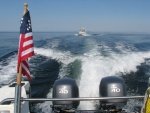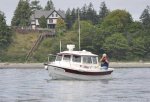John T
New member
- Joined
- Feb 22, 2016
- Messages
- 42
- Reaction score
- 0
- C Dory Year
- 2018
- C Dory Model
- 255 Tomcat
- Hull Identification Number
- NWM25T01D718
- Vessel Name
- Nashua
My wife and I took delivery on our new TomCat, "Nashua", last Friday, 8/25 and spent a few nights aboard in Anacortes and Friday Harbor before bringing it down on its own bottom to our home in Gig Harbor. This boat rides more smoothly and quietly than anything we have ever owned. We already love it! However, it is a real challenge to dock due to its INWARD counter-rotating props. I'm told that some TomCats are set up this way, while others have the more common (and very easy to maneuver) twin engine configuration of outward counter-rotating props. I'm told that outward rotating props produce cavitation issues on the Tomcat. I wonder how bad those issues are.
Can anyone speak to the pros and cons of each setup on the TomCat?
Thanks much,
John
Can anyone speak to the pros and cons of each setup on the TomCat?
Thanks much,
John


